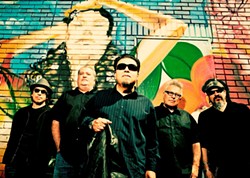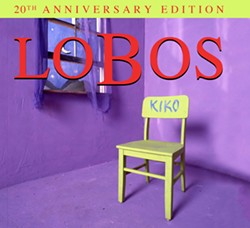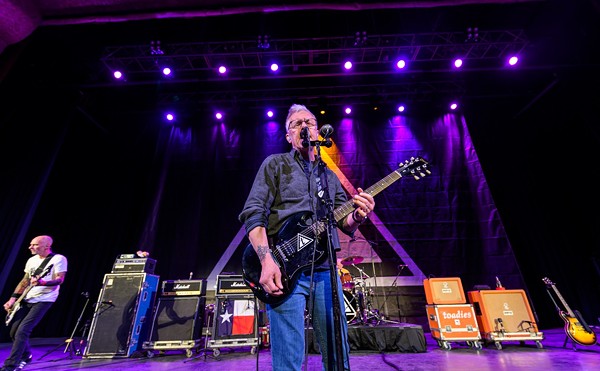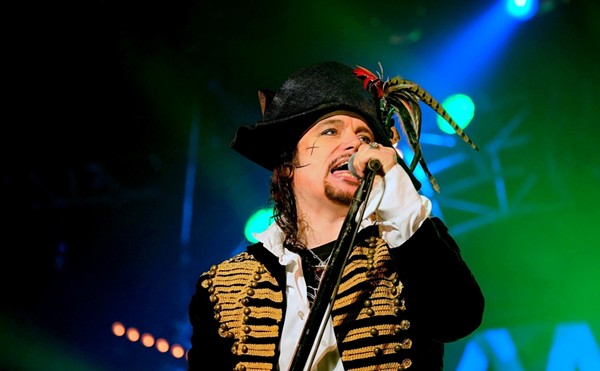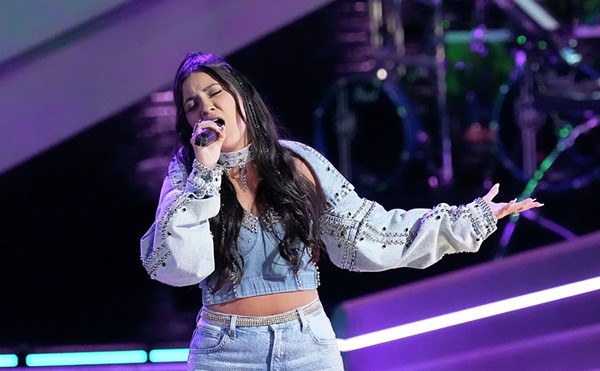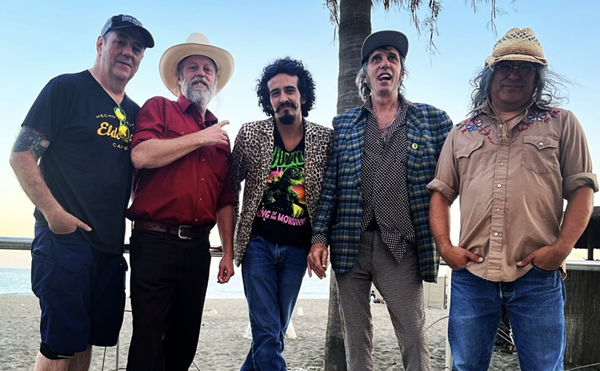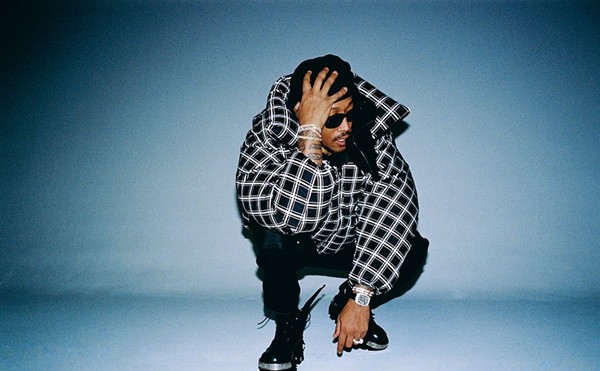Pérez (first from left) and Los Lobos in 2012 (photo by Drew Reynolds)
With the August 21 20th anniversary edition of Los Lobos' masterpiece, Kiko (1992), the East L.A. band celebrates two decades of an album that defined them as a band. The celebration includes the simultaneous release of Kiko Live (recorded at a concert at the San Diego House of Blues in 2006), available on DVD and Blu-ray. The Current spoke to founding member Louie Pérez on the making of the album and the "identity crisis" the band went through after reaching the top of the charts with "La Bamba." Tell Kiko I said happy 20! Thanks! Here is the real kicker: this November we are going to have our 39th anniversary. And in November 2013 we are going to be 40 years old. Why November? We knew the band started at around that time, so from the very beginning we have always picked Thanksgiving to be our anniversary. We would get together and have a barbecue. Now the years go by and it’s like, “Oh, yeah it’s our anniversary. Hey, what time is the flight tomorrow?” (laughs) But it’s great. It’s going to be 40 years and we are going to do a lot of stuff. And with the same lineup for most of those years [saxophonist Steve Berlin joined in 1984]. Yeah, it’s the same set. I don’t know if we hold the record for the original members from the very beginning. It’s amazing. (Sighs) I don’t know... Well, remember we were a band for 10 years before we ever had a record deal or before anything else ever happened to us. The first year was, I think, 1983, with our first record with Warner Brothers [ And a Time to Dance] . That was to kind of legitimize ourselves after doing Just Another Band From East L.A. on our own in 1978. So it’s not like we were a brand new band. We were already adults when we became “rock stars.” So the band is almost 40 and Kiko has just turned 20. Do you ever listen to it? If I never even put the record on or never even listened to another note since [it came out], then it would still stand out in my mind. It was a life-changing experience as a songwriter. Something happened. Talk about blowing minds — that album did it. I don’t even know. Everything just kind of lined up and something happened. I hate using “magical,” but something otherworldly happened in the studio during that time. And, yes, I have listened to the record. To me, it’s as if I hear it and I’m like, “Wow.” It still holds a big place in my life as a songwriter and in the lives of this band. And something happened during that time that I really can’t explain. All I know is the events leading up to it. We released a bunch of cool records and then “La Bamba” happened and we became this big thing. Nobody knew everything else. It almost eclipsed everything else that we had done before. In my own opinion, I think the band went through a little bit of an identity crisis because here we were, “The ‘La Bamba’ Band.” And we had been together for so many years before that. Was it a bittersweet success? I mean, you become number one all of a sudden, but for all the wrong reasons. It was the right reason, because we paid tribute to the legacy of Ritchie Valens. He brought name and prominence to Chicanos. It was Chicanos back then that were doing radical things. I mean, no one had ever taken a 100-year-old canción folklórica and put it to rock 'n' roll, and this was [1958]. That was way, way radical. But I guess what happened was that we kind of sacrificed ourselves for it. At the time we didn’t think it would become as big as it was. And at the time a lot of people would expect [us to do] “the Ritchie Valens Show,” but we didn’t do that. But we didn’t turn ourselves into “The La Bamba Band.” We just did exactly what we had been doing for 15 years at that point. Did you ever purposely refused to play the song live after its success? I think a little bit of that has been sensationalized. Somebody might have said something once, and then somebody told somebody else, and then it would spread out. But we never willfully said, “No, we are not doing it anymore. We are boycotting it.” We just didn’t play it that often anymore because as part of our set, we didn’t always play it. We would play it every now and then or play “Come On, Let’s Go.” We were supporting other records. It wasn’t a part of what we did all the time. So it really didn’t change much. We wouldn’t play it a lot once it became a hit, but later it just became part of our repertoire. I think it would be a little bit insulting to our legacy to say that we refused to play it. But that wasn’t the really the case. So you do play it now? Jimi Hendrix played “Purple Haze” and “Foxy Lady.” And the Doors had to play “Light My Fire.” And on, and on, and on. Bands always have that one hit that they are expected to play and they will play it because people respond to it. Yesterday we played in Seattle at the Zoo and there was a bunch of people, families. It was sold out and we played “La Bamba” because we know that everybody is going to get up on their feet and sing along. So we never had any bad taste about “La Bamba.” It really put Los Lobos on the map. After that, though, we had to work on getting ourselves back on track and getting our audiences educated on the fact that we were more than just “La Bamba.” And we had an identity crisis because, right after the song happened, we may have been expected to do “La Bamba No. 2” to chase after that hit song, and then do something like it. That wasn’t what we were about, though. We had already had a very rich history of original music and had two or three critically acclaimed records. So after “La Bamba” happened, we went to the extreme and released an album of música folklórica, La Pistola y El Corazón, and everybody thought we were crazy. Journalists from coast to coast, all over the place, were saying that Los Lobos committed commercial suicide. So you needed to stop and regroup. That’s exactly right. At that point we were saying, “Ok, who are we? Are we the 'La Bamba Band’ or are we this?” So we went into the attic to find out who we were. We opened it up to find out who we really were. And right inside there was a cardboard box that had our whole Mexican heritage so we decided to focus in the music that really means something to us. And that was música folklórica, because that was the music we started playing as Los Lobos. This was a way for us to pay tribute to our roots and to expose it to a larger audience. I got such a huge smile on my face when I found out people in Helsinki or Tokyo were listening to son jarocho. So it was a really important statement for us to make. We were kind of just grounding ourselves after that big hit. Then came The Neighborhood. That was going back to our roots as rock ’n’ rollers. And after that, we were thinking, “What do we do next?” We already had grounded ourselves and had our originals back on track again. So I think a lot of what happened with Kiko was that we were opening up ourselves to a lot of possibilities. At that point, David [Hidalgo] and I just started writing down some songs and it just went somewhere else. There were no more rules. We went into the studio to not even try. We were just going to let things happen. Mitch Froom and Tchad Blake came in and they were having a similar situation with them too. They had just come off working with Crowded House, a real hit. And they too, as a team of producer/engineer were thinking, “OK, now that we are commercially successful producers, what are we going to do?” So we all found ourselves in the same mental place. So you start working in a shitty studio, and then somebody at the label suggests you give Froom a call. That’s when things really started happening. Yeah. [Froom and Blake] brought everything that they had. They put everything into it and we put everything into it. [Blake] and [Froom] created this environment for us to be comfortable, where we could just try things and do things that were different. And once we got in the studio it was like, “OK, we got a bunch of crayons, and we have a lot of paint. So let’s just make something.” We were open to everything that was going to happen, whatever experiences, discoveries, or music. We had nothing to prove anymore. No one has to tell us if we have a single in here or, “What is this?” We looked at it as just one big piece of canvas and threw all the paint at it to see what came out. It was just a transcendental experience for us. The record almost seemed to make itself. We had no control over it. I never heard a cumbia like “Kiko and the Lavender Moon.” It has a jazzy, psychedelic feel to it, especially when the sax appears. You are right. When David [Hidalgo] came up with the basic idea he was thinking of a cumbia. But the introduction is a Duke Ellington sort of thing. So there is sort of a jazzy element to it. And then we brought it together and the imagery that I wrote was this magic realism sort of thing and it happened without even trying. I just painted this picture with a song and it sounded like a jazz-based cumbia. And the video is superb. That was really interesting. We looked at a bunch of different videos of artists and there was a Czechoslovakian filmmaker [Ondrej Rudavsky]. This guy was like avant-garde and a good video artist. A lot of those effects that he did were all done mechanically. He took a record player turntable and cut out figures on it and he filmed those things going around on a turntable. That’s what I mean by mechanical effects. It was very beautiful.. Let’s talk about the percussion on the album. Right off the bat, with “Dream in Blue,” you can tell something’s going on here. There is a lot of groove on it. The very first track, “Dream in Blue,” has that drum figure. Pete Thomas, from the Attractions, played on most of the record and he could actually pull off this groove. So we told him that there was a song to where this could fit. That groove comes actually from a Jamaican ska tradition. And then you look at something like, “Wake Up, Dolores,” and the percussion on that is more tribal because the theme is of an indigenous, Mexican culture. And then when you look at, “Saint Behind the Glass,” it is a mezcla [mix] of son jarocho and the approach there was different for percussion. The songs were recorded song by song and we would move on only after a song was finished. Songs were being written as they were being recorded, and new ideas were coming up everyday. Tchad Blake was just a genius in the recording studio and was trying all these different techniques. He would take a Shure [SM]57 mic and put it in the bottom of a trash can. We wouldn’t overthink it too much. And although everything was very lush, nothing was over-produced. It was like a painting where you lay down the first colors and then you start to make a shape and then you add other colors when it starts to take form. And musically it was the same: we let the background of the music lead the way. We didn’t rehearse anything. “Whiskey Trail” is a simple, fierce rocker that ends with a bunch of effects, including what I think is a woman screaming. What the hell was that? Wow, I don’t remember that. Hold on, let me play it for you. [Pérez listens through the phone] (laughs.) I don’t know what that was. I do remember that there were a lot of things that Tchad [Blake] brought in because he is a collector of sounds. And somehow that ended up on there. Even if you listen to “Wicked Rain,” the tape machine is just starting up. So there is a lot of that on the record where we are revealing the process of recording. In the whole record there is evidence of being in the studio. I don’t know, man Kiko was such a radical change that I can’t help thinking, “These guys were really having fun there.” Sgt. Pepper’s was supposedly the Beatles’ acid record. Did altered states have anything to do with how magical Kiko came out? I don’t think that is something you would ask Gabriel García Márquez. It’s like asking him, “Were you on drugs?” No, I wasn’t on drugs. Where did that thing come from? I don’t know. I just really don’t have an answer. All I know is that we just got to that point where it became a sort of transcendental sort of experience. And I still look for that when I write. When I am working on a song, there is another place that I go to, and a lot of artists and writers probably do the same thing. They go to another place where there is no time. It is just a zone I get into. When I’m writing a song I have no sense of time or anything. All of us went into this chamber of altered states. Not only the music, but the lyrics are different as well. Even “Wake Up, Dolores” had all those images. I look back at that record and think, “Wow, how did I do that?” And every time I sit down to write it’s almost terrifying because, how could I ever write “Saint Behind the Glass” again? I’m kind of daunted by that. Whenever I think back about that album I think someone else was at work there. We opened up this connection and power that was greater than ourselves and we allowed it to all just come in. I’m not trying to seem like we went into the studio and meditated and lit incense or anything. The only mystery was, how did it all just come together so perfectly? It’s really difficult to describe. Even when we finished the record and listened to it from start to finish we didn’t say anything to each other. We just got up and walked to our cars and went home. It was so surreal. I’ve been trying to find it again. I found a little bit of it with The Town and the City. It’s like when you look at these artists or painters or musicians and they reach a place where everything just seems right and everything just comes out. It’s the master at work on the masterpiece. It’s where artists hit this one spot where something else just takes over and then after that they try to chase after that again. It’s been really difficult for me to find that place again. I’ve come close to it, but I haven’t found it entirely. It’s similar for everyone where a particular album was “it” for the artist. It was the band’s peak, in a sense. That’s what I mean, even though I didn’t want to say that because whenever you think of reaching a peak the only place after the peak is down. And so I’m afraid of using that word. Everyone has said Kiko is Los Lobos’ masterpiece work and that nothing can ever reach that. It’s very difficult to accept that as an artist. It’s difficult but it’s a damn good album, isn’t it? No shit. And then you do Kiko Live, which is a completely naked version of Kiko that proves the songs were there. It wasn’t only about studio wizardry. That’s an excellent way of looking at it. The recorded version of Kiko was just this dense, organic, and psychedelic album, but it wasn’t just all this studio stuff. When you look at Kiko Live and Kiko studio together, you really see how all the songs were really there. That’s what I’m really proud of. When we decided to do the shows for Kiko Live, I think we decided to do seven or eight of them. It was also shot in a film as well. When we set out to do the tour we were just only going to do it for a handful of days. It crossed my mind as to how we were going to reproduce it and recreate that, but once we entered into the rehearsal studio, we started these songs and thought that, “No, we can do this.” Another thing is that when we started putting the songs together for the live tour, the songs held up on their own. It’s not really a big departure. OK, let's look beyond Kiko. I always wated to ask you how you view San Antonio. You guys have a strong connection with San Antonians like Flaco Jiménez, Max Baca, and Steve Earle. When we first toured the U.S., the St. Mary’s Bar and Grill was the very first show we did in Texas, I think. Of course, SA is one of the cities that are predominantly mexicano and Mexican-American. I love San Antonio. As a matter of fact, a good friend of mine, Oscar Garza [former editor at the Los Angeles Times] is from San Antonio. I got San Antonio music coming in and out of my ears all the time, with conjunto and all of that. It has such a rich culture there. Some people I talk to are like, “Ah, I don’t care too much for San Antonio.” Personally, I don’t see what is not to like about it. You’re in the middle of two completely different figures like David Hidalgo and César Rosas. Two superb guitarists and singers, but completely different. How would you describe them? I’ve known them since the very first day in 1973 when we were learning música folklórica, and there has always been this interesting balance. Vocally they are completely different. César can sing the boleros, while David can sing the huastecos. As a rockero, César can sing more of the really Johnny Hooker blues, and David can break your heart and sing “A Matter of Time.” And as songwriters, César offers up the cumbias and the blues tunes and David and I share more of the dense-cerebral stuff. Somehow, we throw them in there and it becomes the sounds of Los Lobos. So I can only describe it as a marriage between the two styles, and it works. And as guitarists? David [Hidalgo] is a sound-shaper, and César is more of a blues/rock ’n’ roll style. David can shape these sounds, he’s a phenomenal guitar player. And César also plays so well. They’re equally soulful, but César offers more of a gritty rock style. I’m the man in the middle. Yeah... But you can play everything, man, even drums. By the way, who’s playing drums now? We have a new drummer now. He is from Monterrey, Nuevo León. His name is Enrique González. They call him “Bugs.” Do you remember that band from Mexico called Jumbo? Of course! Don’t tell me you got Jumbo’s drummer. Yeah, we got the drummer. How did that happen? Cougar Estrada, who had been with us for about 10 years, recently became a father for the first time and got married. Things really changed for him and he really just wanted to stay at home and raise a family. So you can’t argue with that, so he left and then we found Enrique, “Bugs,” through Steve [Berlin], who had worked with him on something else. We brought him in and he immediately just fell right into place. So you’re now concentrating on guitar? I’ve been in the front playing guitar for many years now. Yeah, but I always see you changing instruments. Yeah, I move around. For the Tex-Mex stuff I play drums. But mostly I’m upfront and play jarana, and every now and then solos on the electric guitar. It feels like I’m back in 1973 again. — Enrique Lopetegui
